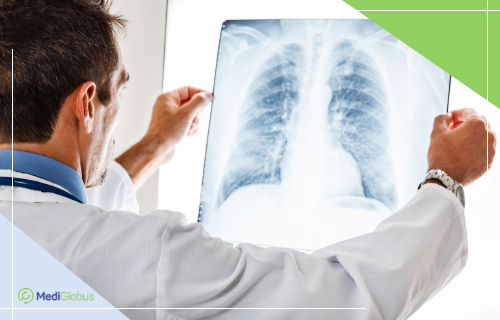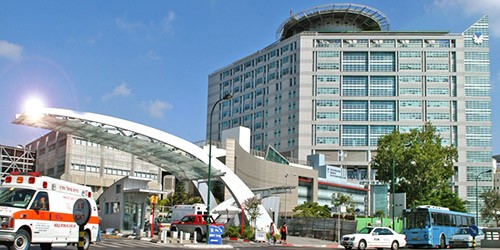1. About primary lung lymphoma |
2. Treatment of primary lung lymphoma |
3. About secondary lung lymphoma |
4. Treatment of secondary lung lymphoma |
5. Recommended clinics |
Doctors distinguish two types of lung lymphoma: primary and secondary. Primary lung lymphoma forms in this organ and is usually limited to it. A more common secondary lung lymphoma is a metastasis of Hodgkin and non-Hodgkin lymphomas. These two groups differ in course, histology, treatment and prognosis. They will be discussed in our article.
Primary lung lymphoma – what is it?
Primary lung lymphoma is a disease that involves the spread of lymphoid tissue in one or two lungs without cancer in other organs. It is quite rare, occurring in less than 1% of patients with pulmonological diagnoses.
The rarity of this disease makes proper diagnosis and treatment planning difficult, especially if the patient goes to non-specialised centres. However, at the same time, the slow course favours successful treatment and for most patients the prognosis is optimistic.
The group of “primary lung lymphomas” includes several diseases that share similar symptomatology and diagnostic characteristics:

MALT lymphoma is a slow-flowing form of lymphoma that forms from B-lymphocytes of mucosal tissue. The disease is often asymptomatic. The prognosis of treatment is good, but it is characterised by periods of improvement and deterioration.
High-grade B-cell lymphoma – this diagnosis is much rarer and usually occurs in people with comorbidities (e.g. immunodeficiency). The prognosis for treatment of this lymphoma is complex, and therapy options depend on the patient’s overall health.
Lymphomatoid granulomatosis is a rare disease caused by the Epstein-Barr virus. Prognosis and treatment can vary significantly depending on the degree of histological malignancy.
Primary pulmonary plasmacytoma and pulmonary intravascular lymphoma are two very rare forms of pulmonary lymphoma.
Primary lung lymphoma usually develops in patients aged 60-70 years, affecting men and women in approximately equal proportions. In more than half of the cases, the disease is asymptomatic, but it may present itself with cough, mild shortness of breath, chest pain, wheezing, and sometimes haemoptysis.
Diagnosis and treatment of primary lung lymphoma
The main method of diagnosing primary lung lymphoma is chest radiography. The scan typically shows several small nodes, as well as accompanying signs of organ dysfunction – pleural effusions, air bronchograms, etc. To make an accurate diagnosis, a biopsy (removal of a tumour sample with a needle) and immunohistochemistry (in-depth laboratory analysis of a tissue sample) must be performed.
The following factors are considered criteria for diagnosis:
Lung and/or bronchial lesion, on one or both sides, without evidence of mediastinal lymphadenopathy or mass on chest radiograph;
absence of previous extrathoracic lymphoma;
no evidence of extrathoracic lymphoma or lymphoblastic leukaemia at the time of diagnosis;
absence of extrathoracic disease outside the chest for at least three months after initial diagnosis.
The treatment of primary lung lymphoma predominantly depends on the specific course of the disease.
For single tumours, surgery or radiation therapy is possible;
For multiple tumours, chemotherapy or chemotherapy together with targeted therapy is prescribed.
Whenever possible, doctors favour gentler treatments, especially for older patients. Controlling side effects, comorbidities and maintaining a normal condition are a high priority in foreign cancer centres.
The prognosis for the treatment of the disease depends significantly on the grade of the tumour. If it is higher, the tumour will behave more aggressively and require more active treatment, but such a diagnosis is also associated with a lower rate of therapeutic efficacy. Slow-growing forms of primary lung lymphoma, particularly MALT lymphoma, are often diagnosed in the first stages and are successfully treated in 90-95% of patients.
SIGN UP FOR CANCER TREATMENT
To book your cancer treatment abroad, click on the button below and fill in the form. Our coordinators will call you back within 30 minutes. They will provide all the information you need and help you with your travel arrangements.
Secondary pulmonary lymphoma
Secondary pulmonary lymphoma is a form of cancer in which the disease is not confined to the lung and has involvement of mediastinal lymph nodes or evidence of extrathoracic spread for at least three months after the initial diagnosis. This is the more common form of pulmonary lymphoma.
There are two common forms of secondary pulmonary lymphoma, and another less common:
Hodgkin lymphoma | Hodgkin lymphoma refers to a group of cancers that originate from lesions on lymphocytes. The most common types of Hodgkin lymphomas are chronic lymphocytic leukaemia, subcutaneous B-cell lymphoma and subcutaneous T-cell lymphoma. |
Non-Hodgkin’s lymphomas | The main difference between non-Hodgkin lymphomas and Hodgkin lymphomas is the absence of Reed-Sternberg lymphocytes. This group of diseases is considered more unpredictable and difficult to treat, but lung damage is less common (about 4%). |
Lymphoma in immunocompromised patients | Lung lymphoma can develop in immunocompromised patients, as well as after an organ transplant or bone marrow transplant. The disease is caused by a weakened immune system, which is a necessary step during the transplant process for the transplanted organ to take root. However, this syndrome is not very common (2-20% of patients) and rarely causes the development of lymphoma. If it does occur, the prognosis is relatively favourable. |
Non-Hodgkin’s lymphoma is more common in people over 55 years of age, and the average age of a patient with Hodgkin’s lymphoma is 39. The prognosis and treatment of secondary lung lymphoma will depend on the type of disease.
Diagnosis and treatment of secondary lung lymphoma
X-rays or CT scans are most commonly used to diagnose lung lymphoma. On imaging, tumours often look very similar to primary lung lymphoma and can take on different shapes – masses, nodules, opacities, etc. Therefore, the professionalism of the expert diagnostician is very important for the correct diagnosis, as well as properly selected additional studies, the main of which is a biopsy.
Symptoms of secondary lung lymphoma can also be diverse and resemble a large number of diseases, both oncological and non-oncological. Because of this, doctors take a comprehensive diagnostic approach and perform a very thorough examination. Similarly, any new lung lesion with a current or past diagnosis of lymphoma should be considered with suspicion of spread or recurrence of the disease.
In many cases, the involvement of the lungs in the cancer process indicates that the disease has reached stage 4, the spread of metastases to distant sites in the body. Therapy often includes intensive courses of chemotherapy and radiotherapy.

The most innovative treatments for lymphoma are bone marrow transplantation (BMT) and CAR-T therapy. These can significantly improve a patient’s prognosis and are effective even after standard treatment protocols have failed to produce the expected results.
The prognosis of stage 4 lymphoma treatment varies depending on the subtype of cancer and averages 57-82%.
Where to go for lung lymphoma treatment?
Summary
Lung lymphoma is a group of diseases characterised by the involvement of one or two lung lobes with tumour formation. The disease may be aggressive or slow-growing and may be confined to an organ or involve the whole body.
The main treatments for lung lymphoma are chemotherapy, radiation therapy and surgery. CAR-T therapy or bone marrow transplantation may be indicated for some patients.
For lung lymphoma treatment, the international platform MediGlobus recommends hospitals in Turkey (Liv, Koç), Israel (Ichilov), Spain (Uniclinica Navarra), South Korea (SoonChunHyang) and China (Fuda).
SIGN UP FOR CANCER TREATMENT
To enrol for cancer treatment abroad, click on the button below and fill out the form. Our coordinators will call you back within 30 minutes. They will provide all the information you need and help you with travel arrangements.
Sources:
- 1. Orphanet
- 2. Lung India
- 3. European Respiratory Journal
- 4. Cancers
- 5. Cancer Journal
- 6. Annals of Oncology
- 7. Cureus
- 8. Statpearls: Posttransplant Lymphoproliferative Disorders
- 9. American Cancer Society: Non-Hodgkin Lymphoma
- 10. American Cancer Society: Hodgkin’s Lymphoma











